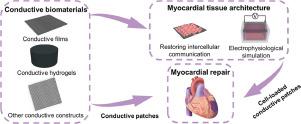Acta Biomaterialia ( IF 9.4 ) Pub Date : 2021-04-20 , DOI: 10.1016/j.actbio.2021.04.018 Yimeng Li 1 , Leqian Wei 1 , Lizhen Lan 1 , Yaya Gao 1 , Qian Zhang 1 , Hewan Dawit 1 , Jifu Mao 1 , Lamei Guo 2 , Li Shen 3 , Lu Wang 1

|
Myocardial infarction (MI) is one of the fatal diseases in humans. Its incidence is constantly increasing annually all over the world. The problem is accompanied by the limited regenerative capacity of cardiomyocytes, yielding fibrous scar tissue formation. The propagation of electrical impulses in such tissue is severely hampered, negatively influencing the normal heart pumping function. Thus, reconstruction of the internal cardiac electrical connection is currently a major concern of myocardial repair. Conductive biomaterials with or without cell loading were extensively investigated to address this problem. This article introduces a detailed overview of the recent progress in conductive biomaterials and fabrication methods of conductive scaffolds for cardiac repair. After that, the advances in myocardial tissue construction in vitro by the restoration of intercellular communication and simulation of the dynamic electrophysiological environment are systematically reviewed. Furthermore, the latest trend in the study of cardiac repair in vivo using various conductive patches is summarized. Finally, we discuss the achievements and shortcomings of the existing conductive biomaterials and the properties of an ideal conductive patch for myocardial repair. We hope this review will help readers understand the importance and usefulness of conductive biomaterials in cardiac repair and inspire researchers to design and develop new conductive patches to meet the clinical requirements.
Statement of significance
After myocardial infarction, the infarcted myocardial area is gradually replaced by heterogeneous fibrous tissue with inferior conduction properties, resulting in arrhythmia and heart remodeling. Conductive biomaterials have been extensively adopted to solve the problem. Summarizing the relevant literature, this review presents an overview of the types and fabrication methods of conductive biomaterials, and focally discusses the recent advances in myocardial tissue construction in vitro and myocardial repair in vivo, which is rarely covered in previous reviews. As well, the deficiencies of the existing conductive patches and their construction strategies for myocardial repair are discussed as well as the improving directions. Confidently, the readers of this review would appreciate advantages and current limitations of conductive biomaterials/patches in cardiac repair.
中文翻译:

用于心脏修复的导电生物材料:综述
心肌梗塞(MI)是人类的致命疾病之一。其发病率在全世界每年都在不断增加。该问题伴随着心肌细胞的有限再生能力,导致纤维性瘢痕组织形成。这种组织中电脉冲的传播受到严重阻碍,对正常的心脏泵血功能产生负面影响。因此,内部心脏电连接的重建目前是心肌修复的主要关注点。广泛研究了具有或不具有细胞负载的导电生物材料以解决该问题。本文详细介绍了导电生物材料的最新进展以及用于心脏修复的导电支架的制备方法。此后,心肌组织建设的进展体外通过恢复细胞间通讯和模拟动态电生理环境进行了系统综述。此外,总结了使用各种导电贴片进行体内心脏修复研究的最新趋势。最后,我们讨论了现有导电生物材料的成就和不足,以及理想的心肌修复导电贴片的特性。我们希望这篇综述能帮助读者了解导电生物材料在心脏修复中的重要性和实用性,并激发研究人员设计和开发新的导电贴片以满足临床要求。
重要性声明
心肌梗塞后,梗塞的心肌区域逐渐被传导性能较差的异质纤维组织所取代,导致心律失常和心脏重构。导电生物材料已被广泛采用来解决这个问题。总结相关文献,综述了导电生物材料的种类和制备方法,重点讨论了体外心肌组织构建和体内心肌修复的最新进展。,这在以前的评论中很少涉及。并讨论了现有导电贴片的不足之处及其对心肌修复的构建策略以及改进方向。有信心,本综述的读者会欣赏导电生物材料/贴片在心脏修复中的优势和当前局限性。





















































 京公网安备 11010802027423号
京公网安备 11010802027423号